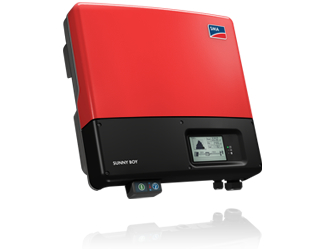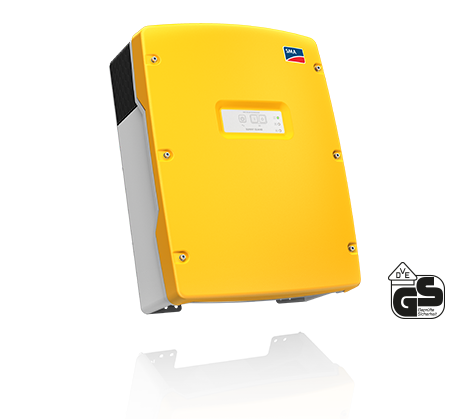Home solar energy storage is quickly coming into the mainstream in Australia, thanks to the low cost of solar PV installations here. Every home that installs a battery storage system will need an inverter to convert the stored DC electricity into grid & appliance-friendly AC electricity. The two main choices available are battery-specific inverters and so-called ‘hybrid’ or multi-mode inverters. What are the relative strengths and weaknesses of each of these types of solutions with regard to the role they play in energy storage systems?
 Standard solar PV inverters
Standard solar PV inverters
The basic function of a solar PV inverter is to convert the DC electricity generated by solar panels into AC electricity. Although individual products may each have their own bells & whistles, without performing this integral function they cannot be called an inverter. Solar PV inverter brands are plentiful in Australia – SMA, Fronius, ABB/Power-One, Growatt, Samil and Zeversolar are just a handful of the popular brands here.
Pros:
- Time-tested technology – used widely in grid-connected solar systems around the world
- Countless product options available
Cons:
- Possible to include battery storage, but battery side of the system will require a separate inverter
- Separate energy management system may be required to maximise overall system efficiency
 Hybrid solar inverters
Hybrid solar inverters
In the context of residential solar+storage systems, a hybrid inverter (sometimes referred to as a multi-mode inverter) is an inverter which can simultaneously manage inputs from both solar panels and a battery bank, charging batteries with either solar panels or the electricity grid (depending on which is more economical or preferred). Their capabilities may go beyond this however – some devices also handle inputs from wind turbines, generators and other power sources.
Pros:
- All-in-one inverter solution for grid-connected solar-plus-storage systems
- Frequently intelligent and programmable for maximising overall system efficiency and savings
- Can usually be installed without batteries for future expansion
- Long history of use in off-grid and stand-alone power systems
Cons:
- Less design flexibility than modular solutions which use separate PV and battery inverters
- Generally less efficient than dedicated solar-only or battery-only inverters
Hybrid inverters available in Australia:
(If you notice something incorrect or missing from this list, please notify us via email on communications@solarchoice.net.au.)
| Fronius – Symo Hybrid |
| Giant Power – Hybrid IGS |
| GoodWe – ES Series |
| ReneSola – RePlus |
| RESA – Voltlogic |
| Selectronic – Solar Hybrid |
| SMA – Sunny Boy Smart Energy (Hybrid with battery attached) |
| SolaX – X Hybrid Series |
| SolaX – X Hybrid Plus Series |
| SunGrow – SH 5K |
 Battery inverters
Battery inverters
Battery-specific inverters manage the charging and discharging of a battery bank. Just as with other inverters, their job is to convert DC electricity into AC electricity, but they also do the reverse – converting AC electricity into DC in order to charge a battery bank. Battery inverters can be installed into homes where no solar PV system exists for purposes of energy arbitration (i.e. using cheap off-peak grid electricity for battery charging), but most homes are more likely to install them in order to capture and store excess solar energy. Their modular nature means that they can be retrofitted relatively easily onto existing solar PV systems.
Pros:
- Modular nature lends to greater system design flexibility
- Long history of use in off-grid and stand-alone power systems means most units are exceptionally sturdy and durable
- Can be relatively easily retrofitted onto existing solar PV systems for addition of battery storage
Battery-only inverters available in Australia:
(If you notice something incorrect or missing from this list, please notify us via email on communications@solarchoice.net.au.)
| Giant Power – OffGrid IPS |
| SMA – Sunny Island |
| SMA – Sunny Boy Storage (compatible with Powerwall) |
| Schneider – Context |
| Selectronics – SP Pro AU Series |
| Selectronics – SP Pro GO Series |
| Latronic Sunpower – LS Series |
| Latronic Sunpower – IRM Series |
| Victron – Various inverters |
What about complete solar-plus-storage solutions?
There are also a number of energy storage products available in Australia that are comprised of a hybrid inverter plus batteries – all-in-one, plug-and-play solutions. We will be publishing an article with a list of these devices soon. Please sign up for our newsletter using the form below to receive weekly updates.
Interested in energy storage for your home?
On the back of the success of our informative and impartial Solar Quote Comparisons, Solar Choice has developed an online comparison platform for energy storage solutions.
- If you are looking for a new solar-plus-storage system, fill out the form to the right of this page to get instant quotes from installers in your area
- If you are looking to retrofit batteries onto an existing solar PV system, please enter your details into the form below – we will get back to you when this functionality is live on our site.
© 2015 Solar Choice Pty Ltd
- Solar Power Wagga Wagga, NSW – Compare outputs, returns and installers - 13 March, 2025
- Monocrystalline vs Polycrystalline Solar Panels: Busting Myths - 11 November, 2024
- Solar Hot Water System: Everything You Need to Know - 27 February, 2024
Is battery inverter only for battery? I found sth called ME 3000SP from Shenzhen Sofar Solar. It looks like a battery inverter with AC charger.
Hi Sylvia,
Yes, the job of a battery inverter/charger is to turn change the DC to AC (for battery discharging) and AC to DC (for battery charging). A hybrid inverter can also handle input from solar panels at the same time.